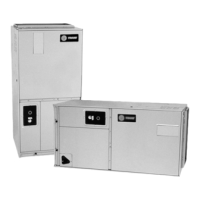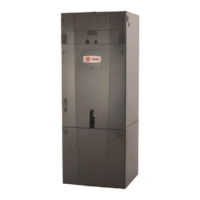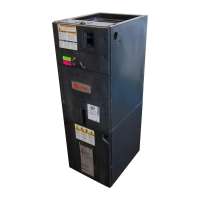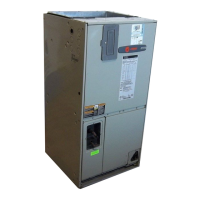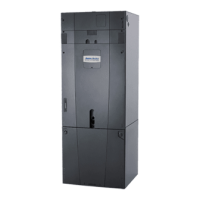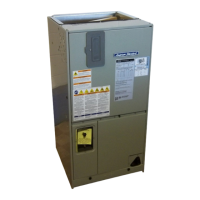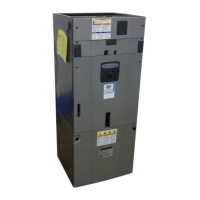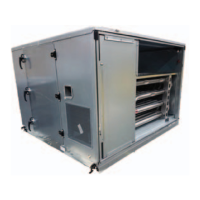System Start-up
RT-SVX35H-EN 95
has a clearly defined shape, and is primarily (75%) blue
in color with an orange tip.
5. Check the manifold gas pressure by using the manifold
pressure port on the gas valve. Refer to Table 33, p. 95
for the required manifold pressure for high-fire
operation. If it needs adjusting, remove the cap
covering the high-fire adjustment screw on the gas
valve. Refer to Figure 52, p. 96 for the a
djustment
screw location. Turn the screw clockwise to increase
the gas pressure or counterclockwise to decrease the
gas pressure.
6. Use a CO
2
analyzer and measure the percentage of
carbon dioxide in the flue gas. Refer to the illustration
in Figure 50, p. 95. Take several samples to assure that
an accurate reading is obtained. Refer to Table 33 for
the proper CO
2
levels. A carbon dioxide level
exceeding the range in T
able 33 indicates incomplete
combustion due to inadequate air or excessive gas.
Air Volume Adjustment (O
2
)
7. Use an O
2
analyzer and measure the percentage of O
2
in the flue gas. Take several samples to assure an
accurate reading. Compare the measured O
2
level to
the combustion curve in Figure 51, p. 96. The O
2
content of the flue gas should be 4 to 5%. If the O
2
level
is outside this range, adjust
the combustion air damper
to increase or decrease the amount of air entering the
combustion chamber. Refer to Figure 54, p. 99 for the
location of the combustion air damper.
8. Recheck the O
2
and CO
2
levels after each adjustment.
After completing the high-fire checkout and
adjustment procedure, the low-fire setting may require
adjusting.
Low-Fire Adjustment (500 MBH, 850 & 1,000
MBH only)
1. Use the TEST initiation procedures outlined in the
previous section to operate the furnace in the low-fire
state (1st Stage).
2. Use a CO
2
analyzer and measure the percentage of CO
2
in the flue gas. Refer to the illustration in Figure 50,
p. 95. Take several samples to assure that an accurate
reading is obtained. Refer to Table 33, p. 95 for the
proper CO
2
levels. If the measured CO
2
level is within
the listed values, no adjustment is necessary. A CO
2
level exceeding the range in Table 33 indicates
incomplete combustion due to inadequate air or
excessive gas.
3. Check the manifold gas pressure by using the manifold
pressure port on the gas valve. Refer to Table 33 for the
required manifold pressure during low-fire operation.
If it needs adjusting, remove the cap covering the low-
fire adjustment s
crew on the gas valve. Refer to
F
igure 52, p. 96 for the adjustment screw location. Turn
the screw clockwise to increase the gas pressure or
counterclockwise to decrease the gas pressure.
Note: Do not adjust the combustion air damper while the
furnace is operating at low-fire.
4. Check the CO
2
levels after each adjustment.
5. Press the STOP key at the Human Interface Module in
the unit control panel to stop the system operation.
T
able 33. Recommended manifold pressures and CO
2
levels during furnace operation (see notes)
Furnace
Stage MBH
Firing
Rate
Manifold
% CO
2
Pressure
High-Fire 235 100% 8.5-9.5 3.0-3.5
Low-Fire 117 50% 6.0-7.0 0.9
High-Fire 350 100% 8.5-9.5 3.0-3.5
Low-Fire 175 50% 6.0-7.0 0.9
High-Fire 500 100% 8.5-9.5 3.0-3.5
Low-Fire 250 50% 6.0-7.0 1.25
High-Fire 850 100% 8.5-9.5 3.0-3.5
Low-Fire 500 59% 6.0-7.0 1.25
High-Fire 1000 100% 8.5-9.5 3.0-3.5
Low-Fire 500 50% 6.0-7.0 1.25
Notes:
1. Manifold pressures are given in inches w.c.
2. High fire manifold pressure is adjustable on all heaters.
3. Low fire manifold pressure is non-adjustable on 235 MBH and 350
MBH heaters.
Figure 50. Flue gas carbon dioxide & oxygen
measurements
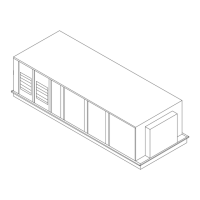
